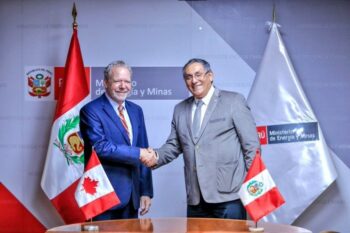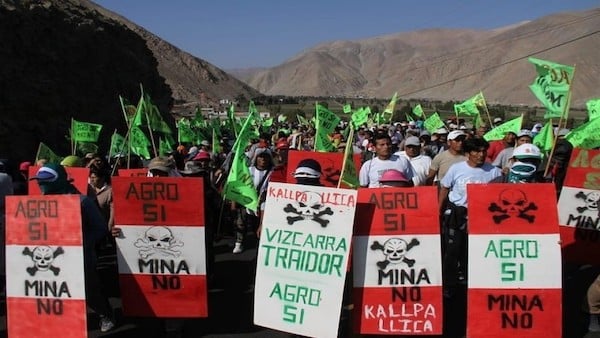On January 18, 2023, as thousands of Peruvians were taking to the streets in Lima to denounce the spiralling political crisis in the country, Canadian Ambassador Louis Marcotte was meeting with the Peruvian Minister of Energy and Mines. Protests have been ongoing since December when populist President Pedro Castillo was deposed from office by congressional vote, a move which was almost immediately condemned by Castillo’s base. Demonstrators have been met with widespread arrests and brutal violence. According to Yves Engler, since former Vice President Dina Boluarte assumed power (a move which the Canadian government endorsed) the Canadian mission has met with numerous top-level Peruvian officials in unprecedented fashion.
Since Boluarte assumed the presidency mobilizations have exploded across the country. Although they differ in their diversity of demands, they coincide along four main points: a call for new general elections for 2023, the closure of congress, Boluarte’s resignation, and the calling of a constituent assembly to draft a new constitution. But these immediate political demands have historical roots. As one collection of Peruvian NGOs stated, the mass movement of Peruvians from the south and peripheral regions is born out of a sense of indignation at a political and economic system which is highly racist and discriminatory. In Puno, the epicentre of protests and extreme police repression, delegations of rural community members travelled to Lima to demand political reforms and solutions to the toxic environmental liabilities which have contaminated their water sources with heavy metals and led to dangerously high toxins (many of which are present in children). With few exceptions, these communities have had their waterways affected by mining and industrial activity.
Ambassador Marcotte tweeted several photos from the meeting, using the occasion to promote mining as a benefit for communities and to express Canadian support for the upcoming Peruvian delegation who will attend the Prospectors and Developers Association of Canada’s (PDAC) annual conference in Toronto from March 5 to 8. Each year, the world’s largest mining convention draws tens of thousands of industry experts, company officials, and government representatives to talk industry trends and promote an expansion of mining—with little concern for the consent of those most affected, including in Peru.
At the time of the meeting, Lima was gridlocked with demonstrations calling for new elections and a constituent assembly. Only days prior, 17 people were killed by police in the cities of Juliaca and Puno. And in the days following the meeting, the oldest university in the country, San Marcos, was invaded by armoured tanks. Hundreds of students and rural protestors were detained, strip searched, assaulted and deprived of their rights. Fifty-nine people have reportedly been killed during the last few months—the overwhelming majority of them civilians from rural and periurban Indigenous and mestizo backgrounds—at the hands of an unbridled police force. It’s unlikely the ambassador could have moved around the city without observing repression and police violence.
For years, MiningWatch Canada and the Justice and Corporate Accountability Project (JCAP), alongside organizations including Red Muqui, Cooperacción, Derechos Humanos Sin Fronteras-Cusco and Derechos Humanos y Medio Ambiente DHUMA, have documented the many harms caused by industrial large-scale Canadian mining to rural communities, as well as the associated police violence that often accompanies the imposition of these projects. While the current protests in Peru are not explicitly about resource extraction, calls for a new constitution to address the systematic and often violent exclusion of Indigenous, peasant and rural peoples from the political economic system, as well as the legacies of land dispossession and contamination, are indeed linked to centuries of extractivism. The ambassador’s tweet has to be taken within a context of centuries of colonial and decades of post-colonial violence against rural peoples at the behest of resource extraction.
The Canadian embassy could have used the moment to publicly denounce police violence and insist the rights of Peruvian protestors be protected. Instead, Ambassador Marcotte chose to promote more Canadian mining investment in the country and plug PDAC 2023—where a session dubbed “Peru Day” promises to discuss “opportunities in the context of enhancing the virtues of the Peruvian mining industry and overcoming the flaws that have slowed down its dynamism in recent years.” Canada’s priorities in Peru could not be more clear.
The economic importance of Canadian mining in Peru
According to the Peruvian Ministry of Energy and Mines, Canada was the third most important investor in mine construction in 2021. Canadian companies invested over $8 billion in 10 projects, representing 15 percent of total investment in mine construction in the country. Canadian companies were the second most important player when it came to exploration (unsurprising, given Canadian companies typically focus on prospecting and exploration) representing 28 percent of the total investment in exploration, with $165 million spent on 21 projects.

Canadian Ambassador to Peru and Bolivia, Louis Marcotte, left, with Óscar Vera, Minister of Energy and Mines of Peru. (Photo: Ministry of Energy and Mines of Peru/Twitter.)
Canadian companies are also operating mines in Peru. Toronto-based Hudbay Minerals operates the Constancia mine; Vancouver’s Pan American Silver operates the Shahuindo and La Arena mines; and Teck Resources’, also headquartered in Vancouver, operates the Antamina mine, with a 22.5 percent ownership stake in the project. Antamina is Peru’s largest mine, ranking among the top 10 producing mines in the world in terms of volume, and is the single most important producer of copper, silver, and zinc in the country. In 2021, the mine generated over $6 billion in revenue and nearly $3.7 billion in gross profits.
Canada also ranks high in terms of importing Peruvian metals and minerals. Of the total value of Peruvian mineral exports in 2021, Canada was the third most important global importer after China and India—coming in at 6.5 percent of total exports. This importance becomes even clearer when considering gold, as Canada was the second largest importer of Peruvian gold. Canadian imports represented over $3 billion in 2021, just shy of two percent of Peru’s GDP for the same year.
When it comes to making statements about egregious human rights violations in the country, however, Canada’s position has been lukewarm. Canada signed the most recent OAS statement on the political crisis in Peru—a watered-down declaration which assigns blame, and thus responsibility, to both protestors and the government of Peru as if they were equal players. The Canadian government continues to parrot this position, even as almost all the victims over the past several months have been civilians killed by an indiscriminate use of police violence—by the same national police force that has signed contracts to provide security to Canadian mining companies.
Private contracts with police
When Canadian mining companies are embroiled in a conflict with local communities outside of Peru, they often depend on henchmen or paramilitary forces to repress dissent. In Peru, companies benefit from state-sanctioned police protection and impunity. Companies can sign service contracts directly with the National Peruvian Police, and off-duty police officers are permitted to work for private security companies while using state property, such as weapons, uniforms and ammunition. Police are guaranteed immunity from criminal prosecution in the event that they fatally injure a protestor. They have the authority to use live ammunition and shoot to kill. And they’ve used it.
Mining companies also benefit from unfettered securitization of their assets. According to local sources, Hudbay’s Constancia mine and MMG’s Las Bambas operations have been fortified under the pretense of “preventing attacks on the mine camps”—effectively state-provided protection that serves to solidify the dominance of these companies in the regions where they operate.
Violence isn’t only used against rural peoples at blockades or during massive marches; it’s a daily occurrence which, according to several international and Peruvian non-governmental organizations, threatens the safety of human rights and environmental defenders and prevents them from exercising their rights. As one report notes, the “existence of these [security] contracts [with the police] creates a hostile scenario that puts human rights at risk.” As the Cusco-based organization Derechos Humanos Sin Fronteras has demonstrated through several environmental and social impact studies related to Hudbay’s Constancia mine, these contracts not only permit explicit state violence, they also form the backdrop of racialized and class-based intimidation and threats against community leaders to prevent them from speaking out against these contracts in the first place.
Promoting Canadian mining at PDAC
During the 2022 PDAC conference, the Peruvian Episcopal Commission for Social Action (CEAS) wrote an open letter to the conference delegates expressing that, contrary to the promises made by Ambassador Marcotte and others, mining has “not brought the promised improvement in quality of life” for most communities in the mining areas. On the contrary, she wrote, “it has resulted in corruption and environmental contamination and has infringed on people’s rights to life and health, leaving behind social conflict, disease and even death.”
These harms are not minimal: contamination of agricultural lands and waterways around Pan American Silver’s Quiruvilca mine and the criminalization of community leaders and land dispossession due to environmental contamination at Shahuindo; violation of Indigenous self-determination and the right to a clean environment around Plateau Energy’s proposed lithium and uranium mine, sitting atop the region’s most important tropical glacier; undercutting of economic benefits for communities most affected by mining operations, and more.
Yet the Canadian embassy in Peru has a track record of ignoring the concerns of human rights and environmental defenders affected by Canadian mining projects in the country—even ignoring the concerns of Canadian citizen Jennifer Moore who was detained in 2017 by Peruvian police while screening a documentary film with Quechua communities affected by Hudbay’s Constancia mine. Moore, who was subsequently banned from re-entering the country and labelled a threat to national security, is the focus of a recent report by the Justice and Corporate Accountability Project (JCAP) on the role of Canadian embassies in prioritizing the interests of Canadian mining companies at the expense of their own policies and commitments regarding the protection of human rights defenders.
The Canadian embassy in Peru will no doubt continue to work alongside the Peruvian Ministry of Energy and Mines to promote more Canadian mining investment in the country. But it should be made clear: when the embassy chooses to promote mining in Peru during PDAC, it is doing so knowing the reality of what these activities mean for people who are facing ongoing threats, intimidation, and explicit state-sponsored violence.
Dr. Kirsten Francescone is an assistant professor in International Development Studies at Trent University and former Latin America Program Coordinator for MiningWatch Canada.

